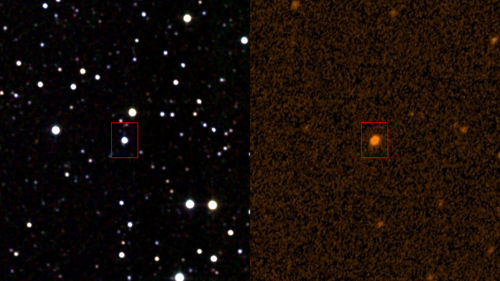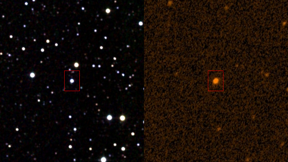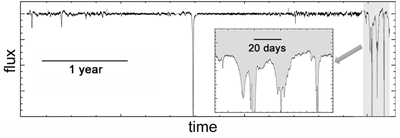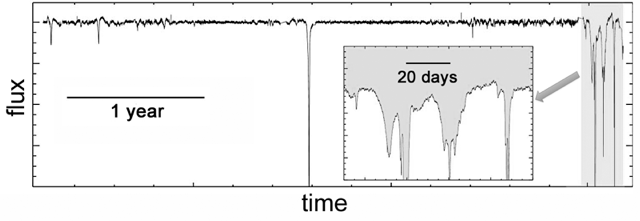New Clues as to Why Boyajian’s Star is Dimming
Planet Hunters (https://www.planethunters.org) is a citizen science effort to search for planets by analyzing publicly available data from NASA’s Kepler mission. Launched in 2009, Kepler detects planets by monitoring the slight decrease in a star’s light flux as an orbiting planet transits in the line of sight. In September 2015, the Planet Hunters announced an unusually pronounced and long dimming event associated with the star KIC 8462852, also named Boyajian’s star for the lead author of the report (Fig. 1) [1]. A transiting planet couldn’t have caused the dimming; most explanations instead involved other larger objects orbiting around the star. Some researchers even speculated that these bodies could be alien megastructures like energy-harvesting solar panels. None of these ideas, however, have satisfactorily explained the observed dimming, which remains a major astronomical mystery.
Now, a useful clue towards solving this puzzle has been offered by Mohammed Sheikh, Richard Weaver, and Karin Dahmen from the University of Illinois at Urbana–Champaign [2]. The researchers analyzed the spectrum of fluctuations in the flux from Boyajian’s star over four years, finding that it followed a universal power-law characteristic of systems close to the critical point of a phase transition. While this result does not reveal the physical processes driving the brightness variations, it suggests that they might be associated with nonequilibrium phenomena occurring within the star, rather than with external orbiting structures.
Boyajian’s star has a 0.88-day rotation period [3], is several hundred million years old, and is about 400 parsecs from Earth [4]. The star has no close companions and appears to be an apparently normal F3V “main sequence” star [1] with no spectral variability or excesses in the infrared spectrum. F3 stars are slightly more massive and hotter than the Sun, mostly radiative, and have a shallow convective layer. Boyajian’s first dimming event was not consistent with a planet transit, and might have been interpreted simply as an unexplained data blip, typical of the early stages of a mission. Then, a couple of years later, the star suddenly dimmed by an extraordinary 15%. This lasted for days, an unusually long time for the dimming of a star. Two years later, it dimmed again by 20%, and the dimming was accompanied by large dips in brightness that had a complex structure (Fig. 2) [1].
The large brightness variations cannot be explained with simple astrophysical models. Normal middle-aged main sequence stars do not exhibit large spontaneous brightness variations. While other stars have been seen to dim by comparable amounts and durations, they were all much younger—in or near the star-forming phase. Boyajian’s star would be a one-in-a-million anomaly. If what blocked the star’s light was an orbiting body, it would have to be comparable in size to the star itself. This rules out planets, whose radius is limited to 50,000 km. Stars can also be excluded because Boyajian’s star has no nearby companion. A diffuse structure, like a disk of dust and debris around the star, could also cause dimming. But such a structure would cause a characteristic infrared emission, which hasn’t been observed [5].
A number of alternative scenarios have been conjectured; Jason Wright and I have classified them in Ref. [6]. One of the scenarios favored by astronomers is a swarm of unusually large comets. This may be plausible as a unique chance occurrence, but fitting the light-flux curves has proved problematic. What’s more, the large number of required comets would release a lot of dust, in tension with the absence of thermal emission from dust. Before the discovery of Boyajian’s star, researchers had postulated that precisely such anomalous dimmings could signal alien megastructures [7]. This is a falsifiable hypothesis and thus scientifically valid. But it remains an implausible explanation, disfavored by Ockham’s razor, if nothing else.
Here, Sheikh et al. consider the sequence of dimming events as a series of local signals, independent of their astrophysical nature. The authors calculate a number of statistical parameters of the dimming, such as the deviation in brightness from the median, the spectrum of fluctuations, and the slope of the log-log distribution of the duration and size of the dimming events. These parameters can be accurately fit with power laws. The analysis suggests that the flux dips are reminiscent of avalanches—sudden changes of a system under an external force. Avalanche statistics are observed in nonequilibrium systems undergoing internal dynamics near the critical point of a phase transition. This occurs, for example, in a ferromagnet close to its ordering temperature and in a magnetic field: when a spin flips to align with the field, it can trigger an avalanche of spin flips that causes a jump in the macroscopic magnetization. Avalanche statistics have been found in astrophysical phenomena, from stellar flares to gamma-ray bursts, and in many critical phenomena in biology and physics. Avalanche models predict a universal behavior for statistical parameters that relate the amplitude, duration, and probability of avalanches, such as the power spectral density function and the time profile of the avalanches. This is exactly what the authors find in the distribution of dimming dips.
The findings of Sheikh et al. are potentially important, as they may provide insight into the nature of the process that is driving the brightness fluctuations, even without revealing exactly what the process is. The authors conjecture that the avalanche statistics indicate an internal stellar process. They further suggest that this behavior may be due to the star approaching the critical point of a magnetic transition. Finding a new process that can drive strong variability in normal main sequence stars would be interesting and surprising, particularly on the time scales of these events, as the duration and interval between the dips are not on time scales natural to F stars.
In the meantime, the situation has been made even more complex by a recent—albeit disputed [8]—finding: archival data have suggested that in addition to the transient variability, the star has undergone dimming on decadal time scales [9]. This progressive dimming of the star is unusual and hard to reconcile with models involving an internal stellar process such as that proposed by Sheikh et al. Likely, the process causing the long-term decreases in brightness is the same physical process causing the large short-term variations in brightness.
Explaining the dimming of Boyajian’s star may not be feasible with Kepler, which only did wideband photometry. Fortunately, there are multiple ongoing efforts to monitor Boyajian’s star from the ground, in the hope of seeing large-scale dimming events at multiple wavelengths and in real time. Such observations could test many of the postulated scenarios. For instance, models postulating foreground dust obscuration from comets or the interstellar medium predict a wavelength-dependent dimming. Finally, further theoretical work should investigate whether the statistics of the brightness fluctuations found by Sheikh et al. could be explained by any process that occurs outside of the star, for example, in the interstellar medium.
This research is published in Physical Review Letters.
References
- T. S. Boyajian et al., “Planet Hunters IX. KIC 8462852 – Where's the Flux?,” Mon. Not. R. Astron. Soc. 457, 3988 (2016).
- M. A. Sheikh, R. Weaver, and K. A. Dahmen, “Avalanche Statistics Identify Intrinsic Stellar Processes Near Criticality in KIC 8462852,” Phys. Rev. Lett. 117, 261101 (2016).
- V. V. Makarov and A. Goldin, “Photometric and Astrometric Vagaries of the Enigma Star KIC 8462852,” Astrophys. J. 833, 78 (2016).
- M. Hippke and D. Angerhausen, “A First View with GAIA on KIC 8462852—Distance Estimates and a Comparison to Other F Stars,” arXiv:1609.05492.
- M. Marengo, A. Hulsebus, and S. Willis, “KIC 8462852: The Infrared Flux,” Astrophys. J. Lett. 814, L15 (2015).
- J. T. Wright and S. Sigurðsson, “Families of Plausible Solutions to the Puzzle of Boyajian’s Star,” Astrophys. J. Lett. 829, L3 (2016).
- J. T. Wright, K. M. S. Cartier, M. Zhao, D. Jontof-Hutter, and E. B. Ford, “The G Search for Extraterrestrial Civilizations with Large Energy Supplies. IV. The Signatures and Information Content of Transiting Megastructures,” Astrophys. J. 816, 17 (2016).
- M. Hippke, D. Angerhausen, M. B. Lund, J. Pepper, and K. G. Stassun, “A Statistical Analysis of the Accuracy of the Digitized Magnitudes of Photometric Plates on the Timescale of Decades with an Application to the Century-long Light Curve of KIC 8462852,” Astrophys. J. 825, 73 (2016).
- B. E. Schaefer, “KIC 8462852 Faded at an Average Rate of 0.164±0.013 Magnitudes per Century from 1890 to 1989,” Astrophys. J. Lett. 822, L34 (2016); B. T. Montet and J. D. Simon, “KIC 8462852 Faded throughout the Kepler Mission,” 830, L39 (2016).







